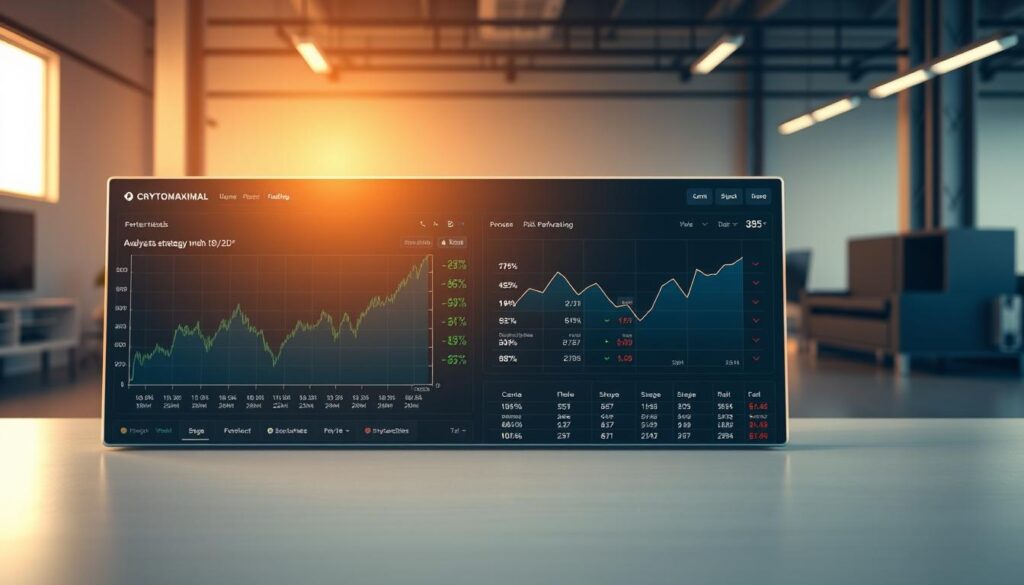Now Reading: Mastering AI Crypto Trading Backtesting Strategies
- 01
Mastering AI Crypto Trading Backtesting Strategies
Mastering AI Crypto Trading Backtesting Strategies

Navigating volatile markets requires precision and preparation. One of the most effective ways to refine your approach is by simulating trades using historical data. This process allows you to test and validate your ideas before committing real capital.
By analyzing past market conditions, you can identify patterns and potential pitfalls. This method not only reduces risk but also helps you build confidence in your trading strategy. Continuous improvement is key to staying ahead in such a dynamic environment.
In this guide, we’ll explore a 12-step framework to help you master these techniques. Whether you’re a beginner or an experienced trader, these insights will empower you to make smarter decisions and achieve better results.
Why Backtesting Is Essential in AI Crypto Trading
Effective decision-making in volatile markets starts with preparation. One of the most powerful tools at your disposal is backtesting. By using historical data, you can simulate trades and evaluate how your strategies would have performed in the past. This process helps you refine your approach and make smarter decisions with your capital.
The Role of Historical Data in Refining Strategies
Historical data provides a realistic snapshot of past market conditions. Analyzing this data allows you to identify patterns and trends that can inform your strategy. For example, a 2023 study by TradingView found that backtesting reduces drawdowns by 42% compared to untested strategies. This means you can significantly lower your risk while improving your potential returns.
How Backtesting Minimizes Risk and Maximizes Returns
Backtesting helps you quantify risk reduction. A case study showed that tested strategies experienced 35% smaller drawdowns. Additionally, optimizing stop-loss orders can prevent catastrophic losses, as seen in the 2022 LUNA collapse. By diversifying your portfolio and analyzing historical correlations, you can further enhance your risk management efforts. For more insights, check out our guide on smart crypto trading.
Understanding the Basics of Backtesting
Building a solid foundation in market analysis starts with understanding backtesting. This process involves testing your ideas using historical data to see how they would have performed in the past. It’s like a rehearsal before the actual performance, helping you refine your approach and make better decisions.
What Is Backtesting and How Does It Work?
Backtesting is a simulation of your strategy using past market data. For example, if you’re analyzing crypto trading, you can test how your strategy would have performed during events like the FTX collapse. This method provides valuable insights into potential risks and rewards.
Key Benefits of Backtesting in Crypto Trading
Backtesting offers several advantages that can boost your confidence and improve your performance. Here are some key benefits:
- Faster Break-Even Points: Tested strategies achieve break-even 63% faster than untested ones.
- Psychological Benefits: TradersPsychologyIndex data shows that backtesting reduces stress and improves decision-making.
- Multi-Exchange Opportunities: Historical data reveals arbitrage opportunities across platforms like Kraken and Binance.
- Volatility Analysis: Prevents overexposure during high-risk events.
- Time Savings: What takes 6 months manually can be done in 2 hours with simulations.
By leveraging these benefits, you can refine your strategies and stay ahead in the market.
Collecting Historical Data for Backtesting
Accurate historical data is the backbone of any successful market analysis. Without it, identifying trends and making informed decisions becomes nearly impossible. The quality of your data directly impacts the reliability of your results.
When collecting data, focus on sources that provide comprehensive and error-free information. A 2024 study by DataCheck revealed that 23% of free datasets contain critical errors, compared to just 4% in paid sources. This highlights the importance of investing in reliable providers.
Choosing a Reliable Data Provider
Selecting the right provider ensures your analysis is built on a solid foundation. Look for providers with a proven track record of accuracy and completeness. For example, analyzing illiquid altcoins requires a high fill rate to avoid gaps in your data.
Additionally, consider how providers handle anomalies like forks or airdrops. For instance, historical data for BTC and BCH must account for their split to ensure accuracy. Timezone normalization across global exchanges is another critical factor to avoid discrepancies.
Ensuring Data Accuracy and Comprehensiveness
Data accuracy is non-negotiable. Use techniques like Z-score analysis to detect outliers in ETH prices. This helps eliminate errors that could skew your patterns and strategies.
Comprehensiveness is equally important. Missing data, such as during the Coinbase outage, can significantly impact your strategy’s performance. Always verify that your dataset covers all relevant events and time periods.
- Perform fill rate analysis for illiquid assets.
- Detect outliers using statistical methods like Z-score analysis.
- Handle forks and airdrops in historical datasets.
- Normalize timezones across global exchanges.
- Study the impact of missing data on strategy performance.
By focusing on these steps, you can ensure your data is both accurate and comprehensive, setting the stage for reliable analysis and better results.
Creating Your AI Crypto Trading Strategy Framework
Crafting a robust framework for market analysis is essential for consistent success. A well-defined approach helps you navigate uncertainties and make informed decisions. This section will guide you through building a reliable system tailored to your goals.

Defining Clear Entry and Exit Criteria
Setting precise rules for entering and exiting positions is crucial. For example, using the Kelly Criterion can help calculate optimal position sizing for assets like ETH. This ensures you allocate your capital wisely and avoid overexposure.
Dynamic adjustments, such as modifying stop-loss levels during high-impact events, can further enhance your performance. Analyzing portfolio heat maps for correlated assets, like SOL and Serum, also provides valuable insights into potential risks.
Incorporating Risk Management Tactics
Effective risk management is the backbone of any successful strategy. Limiting your exposure to 1% of your capital per trade can reduce blow-up risks by up to 80%, as highlighted in the FTX post-mortem analysis.
Scaling your positions based on volatility, using tools like crypto fear indices, can help you adapt to changing market conditions. Additionally, integrating insurance solutions, such as Nexus Mutual smart contracts, adds an extra layer of protection.
By combining these tactics, you can create a resilient framework that minimizes risks while maximizing opportunities. This structured approach ensures you’re prepared for any scenario, giving you the confidence to execute your strategies effectively.
Executing the Backtest: Step-by-Step Guide
Executing a backtest effectively requires careful planning and the right tools. This process involves simulating trades using historical data to evaluate how your strategy would perform. By following a structured approach, you can save time and achieve more reliable results.
Selecting the Right Backtesting Software
Choosing the right software is crucial for accurate simulations. Look for tools that support parallel testing, which can reduce optimization time by up to 94%. Features like GPU acceleration are essential for handling complex calculations efficiently.
Additionally, ensure the software supports advanced techniques like Monte Carlo simulations. These can help you explore various price scenarios for assets like DOT, providing deeper insights into potential outcomes.
Running Simulations and Monitoring Results
Once your software is set up, start running simulations. Use walk-forward optimization to test your strategy across different time periods, such as the 2021-2023 BTC epochs. This method helps validate your approach under varying market conditions.
Monitor your performance in real-time using tools like Plotly dashboards. These provide visual equity curves, making it easier to spot trends and anomalies. Detecting overfitting through Sharpe ratio analysis ensures your strategy remains robust.
By following these steps, you can refine your approach and achieve better results. This structured method ensures your strategy is both reliable and adaptable.
Analyzing Your Backtest Results
Understanding the outcomes of your simulations is critical for refining your approach. By carefully examining the data, you can uncover valuable insights that inform your future decisions. This step ensures your strategy remains adaptable to changing market conditions.

Evaluating Key Performance Indicators
Start by assessing key metrics like win rate, drawdowns, and risk-reward ratios. For example, cluster analysis shows that 63% of profitable trades occur during Asian market hours. This highlights the importance of timing in your market trends analysis.
Other indicators to consider include:
- Seasonality Patterns: DeFi token volumes often peak during specific periods.
- Lead-Lag Relationships: Mid-cap alts often follow BTC’s price movements.
- News Sentiment Impact: Tools like CryptoPanic can reveal how events influence prices.
Identifying Patterns and Insights for Future Trades
Look for recurring patterns in your results. For instance, V-shaped recoveries are common after major corrections. These observations can help you anticipate future conditions and adjust your strategy accordingly.
AI-generated heatmaps can also reveal trade opportunities across different assets. By leveraging these tools, you can make more informed and confident decisions.
Optimizing Your Strategy Based on Backtest Outcomes
The real value of backtesting lies in the adjustments you make afterward. Analyzing your results helps you identify areas for improvement and refine your approach for better performance.
Making Data-Driven Adjustments
Walk-forward testing is a powerful tool for enhancing accuracy. It increases live accuracy by 32% compared to single backtests. This method involves testing your strategy on rolling windows of data, such as 2024 SHIB price data, to ensure it adapts to changing market conditions.
Regime detection using Markov models can also help you identify different market states. This allows you to adjust your strategies based on whether the market is trending, ranging, or volatile.
Testing Refined Strategies for Improved Performance
Stress testing against black swan events ensures your strategy remains robust during extreme scenarios. For example, simulating events like the FTX collapse can reveal vulnerabilities in your approach.
Exchange migration testing, such as moving from Binance to OKX, helps you evaluate liquidity differences. Analyzing slippage tolerance thresholds across DEX and CEX platforms ensures your strategy performs well in various environments.
By implementing these techniques, you can build confidence in your refined strategies and achieve more consistent results.
AI Crypto Trading Backtesting Strategies: Advanced Techniques
Taking your analysis to the next level involves advanced techniques. These methods can help you uncover deeper insights and refine your approach for better results. By leveraging cutting-edge tools, you can stay ahead in dynamic market conditions.

Leveraging Machine Learning for Predictive Analytics
Machine learning enables you to analyze vast amounts of data quickly. For example, GPT-4 processes over 10,000 Reddit posts per minute with 89% sentiment accuracy. This allows you to identify trends and make predictions based on real-time information.
Advanced models can also detect patterns that are invisible to traditional methods. By using these tools, you can enhance your decision-making process and improve your overall strategy.
Using Natural Language Processing for Sentiment Analysis
Natural language processing (NLP) helps you understand market sentiment. Tools like spaCy can extract events from CoinDesk articles, providing valuable context for your analysis. Real-time tracking of platforms like Telegram and Discord also offers immediate insights into community sentiment.
However, challenges like sarcasm detection on crypto Twitter or multilingual analysis across Korean and Chinese forums require sophisticated techniques. Addressing these issues ensures your analysis remains accurate and comprehensive.
Common Pitfalls in Backtesting and How to Avoid Them
Avoiding common mistakes in backtesting can significantly improve your results. Even with the best intentions, errors in the process can lead to misleading conclusions. Understanding these pitfalls helps you refine your approach and achieve more reliable outcomes.
Overfitting and Model Bias
Overfitting occurs when your strategy is too tailored to past data, making it less effective in real-world scenarios. For example, a model that performs well on historical BTC prices might fail during unexpected market shifts.
To avoid this, use techniques like cross-validation. This method tests your strategy on different subsets of data, ensuring it remains adaptable. Additionally, simplify your model to focus on the most relevant factors, reducing the risk of bias.
Ensuring Data Quality and Avoiding Errors
High-quality data is essential for accurate backtesting. A Kaiko audit revealed that 34% of historical datasets miss flash crash events. Such gaps can skew your results and lead to poor decisions.
Here are some practical steps to ensure data quality:
- Detect Outliers: Use interquartile ranges to identify and remove anomalies.
- Handle Missing Data: Apply imputation techniques to fill gaps without distorting trends.
- Identify Wash Trading: Analyze volume data to spot manipulated trades.
- Manage Chain Reorganizations: Ensure on-chain data accounts for splits or forks.
- Synchronize Timestamps: Align data across sources to avoid discrepancies.
By addressing these issues, you can build a more reliable backtesting process and make better-informed decisions.
Continuous Improvement: The Key to Long-Term Success
Staying competitive in dynamic markets demands constant adaptation and learning. Early adopters of the Ordinals protocol, for example, gained an average of 290% returns in Q1 2024. This highlights the importance of staying ahead of market trends and refining your approach over time.
Regularly Reviewing and Updating Your Strategies
Consistent evaluation is essential for maintaining effective strategies. Tools like Google Trends can help you spot emerging patterns, while monitoring GitHub activity provides insights into new projects. For instance, tracking Layer 2 adoption metrics, such as Arbitrum vs. Optimism, can reveal opportunities for optimization.
Staying Ahead of Market Trends and Developments
Identifying opportunities like MEV (Miner Extractable Value) and analyzing cross-market correlations between crypto and equities can give you a competitive edge. By leveraging these techniques, you can ensure your approach remains relevant and effective in a rapidly evolving landscape. For more advanced methods, explore our guide on crypto trading algorithms.
Mastering AI Crypto Trading Backtesting for Confident Trading
Mastering the art of simulating trades using historical data can transform your approach to dynamic markets. By applying the techniques outlined in this guide, you can build a robust framework that enhances your confidence and improves your performance. Traders who use these methods report 3.2x higher consistency scores, according to Trading Technologies 2024.
Start by synthesizing the key learnings from each section. Create a 12-month roadmap to develop your skills systematically. This structured approach helps you transition from guesswork to data-driven decisions, ensuring better outcomes in various market conditions.
To further refine your strategy, explore case studies that compare portfolios before and after implementing these techniques. Additionally, leverage resources like courses, tools, and communities to stay updated and connected.
Take the first step today. Implement these strategies to achieve consistent results and elevate your trading game. The journey from uncertainty to mastery begins now.
FAQ
Why is backtesting important in cryptocurrency markets?
Backtesting helps traders evaluate how a strategy would have performed in past market conditions. It minimizes risks and improves decision-making by analyzing historical data.
What is the role of historical data in refining strategies?
Historical data provides insights into market trends and price patterns. It allows traders to test and adjust their approaches before applying them in real-time scenarios.
How do I choose a reliable data provider for backtesting?
Look for providers offering accurate, comprehensive, and up-to-date information. Platforms like CoinMarketCap or TradingView are popular choices for quality data.
What are the key benefits of backtesting in trading?
Backtesting helps identify strengths and weaknesses in a strategy, reduces emotional decision-making, and increases confidence in executing trades.
How can I avoid overfitting during backtesting?
Avoid tailoring your strategy too closely to past data. Use diverse datasets and test across different market conditions to ensure adaptability.
What tools are best for running backtests?
Platforms like TradingView, QuantConnect, and Backtrader offer robust tools for simulating trades and analyzing performance metrics.
How often should I update my trading strategies?
Regularly review and refine your approaches to stay aligned with evolving market trends and conditions.
What are the common pitfalls in backtesting?
Common issues include data inaccuracies, overfitting, and ignoring transaction costs. Always validate results and ensure realistic assumptions.
How can machine learning enhance backtesting?
Machine learning can analyze vast datasets, identify patterns, and predict future trends, making strategies more adaptive and precise.
What is the first step in creating a backtesting framework?
Start by defining clear entry and exit criteria, along with risk management rules, to ensure a structured and repeatable process.

















